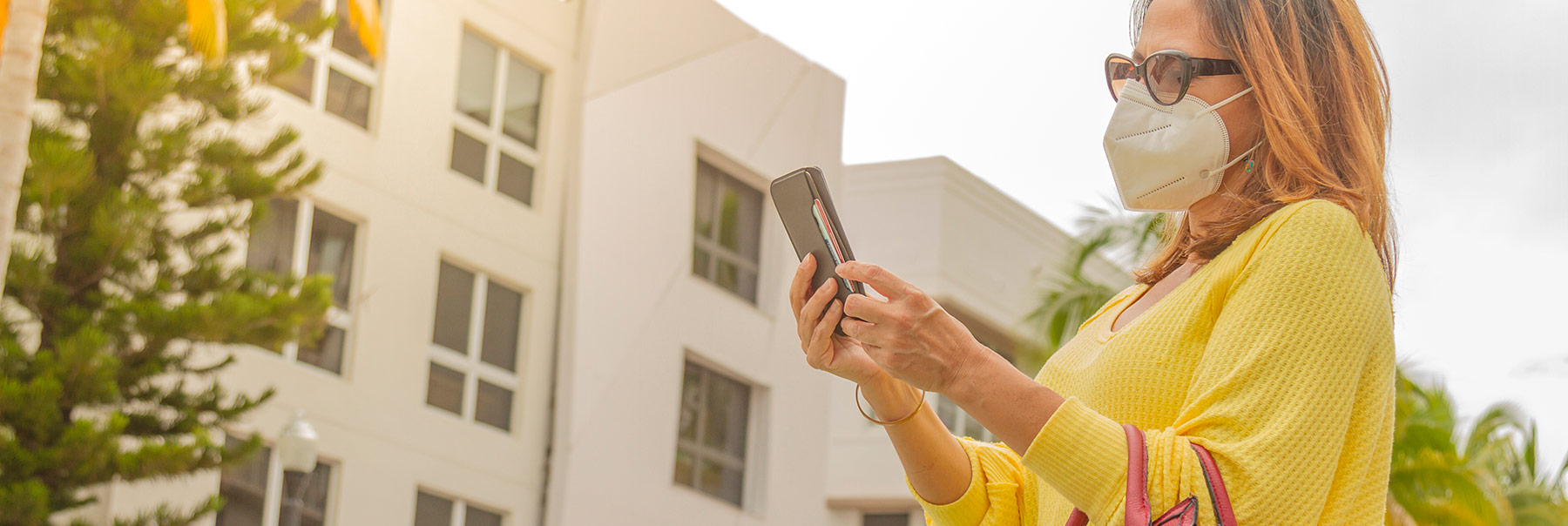Mask Up – It Still Saves Lives

If you’re wondering why everyone is talking about face masks, the answer is simple. Research shows that when we wear masks properly and consistently, we can slow the spread of coronavirus and save lives.
“We are not defenseless against COVID-19,” said CDC Director Dr. Robert R. Redfield. “Cloth face coverings are one of the most powerful weapons we have to slow and stop the spread of the virus — particularly when used universally within a community setting. All Americans have a responsibility to protect themselves, their families, and their communities.”
How are masks helpful?
According to the CDC, the main purpose of wearing a face covering is to catch your respiratory particles to prevent them from entering the air and being inhaled by others. You can be infected with COVID-19 without having any symptoms, so it’s essential to wear a mask even when you don’t feel sick. Wearing a mask also helps protect you by filtering respiratory particles from the air you breath in.
For masks to be most effective, everyone must wear one properly.
What are the latest mask guidelines?
As of December 1, 2020, the World Health Organization recommends that everyone over age 2 wear a non-medical mask when indoors in public places. Adults age 60 and older and anyone with an underlying health condition is at higher risk and should wear a medical mask in all public settings when proper ventilation and physical distancing aren’t possible.
The CDC supports these recommendations and offers guidelines on how to select, wear, and clean your mask. Don’t forget to wash or sanitize your hands before you touch or remove your mask. Try to avoid touching the mask while you’re wearing it.
How to choose the right personal protection.
The key to protecting yourself and others? Wear the right kind of mask with a good fit over your nose and mouth.
To prevent the spread of disease, your mask should:
- Have at least two layers of fabric
- Have a filter, if possible
- Fit snuggly but comfortably against the sides of your face without gaps
- Be washable without losing its proper fit or shape
- Allow you to breathe comfortably
Bandanas and face shields worn without masks have been shown to be the least effective at preventing the spread of respiratory particles. If you’re feeling crafty, you can make your own mask, even without sewing. The CDC and WHO emphasize that surgical masks and N-95 respirators should be reserved for healthcare workers and medical first responders.
Yes, you need to wash your mask.
Your mask should be washed (or replaced) frequently, depending on how often you leave the house. This is important, as the mask itself could become a method of spreading the virus if not cleaned properly. Most cloth face coverings can be cleaned effectively in the washing machine. You can treat them as part of your regular laundry loads, just like socks and underwear. Or you can hand wash them in the sink.
Are masks making your skin break out?
If you wear eyeglasses …
If you wear glasses, then you know that face masks can pose an additional challenge: foggy lenses. To help with this challenge, Stephanie Frankel, O.D., an optometrist with Bascom Palmer Eye Institute, offers the following tips:
Get a mask with an adjustable nose piece. Being able to adjust the fit of the mask against your nose and cheeks can help prevent foggy glasses. “Patients who are making their own masks can achieve this by sewing in a pipe cleaner or similar object to allow for adjustment,” says Dr. Frankel.
Add some tape. If your masks don’t have an adjustable nose piece, you can solve the problem with a piece of surgical tape over the top of the mask where it meets the nose and cheeks.
Treat the glasses. Another way to prevent foggy glasses is to treat the lenses. Dip them in soapy water, and then use a lens cloth to rub them clean. Or apply shaving cream to the lenses and clean them off with water. Both approaches leave a thin film on the lenses that prevents fogging.
Should I wear a mask while exercising?
For that answer, we turn to orthopaedic expert Stephen Henry, D.O., at the Sports Medicine Institute. He discusses when and how to safely wear a mask while working out, running, or playing sports.
The bottom line on COVID-19 prevention
Wearing a mask is not enough on its own to protect you 100% from catching or spreading COVID-19. Hand sanitation, physical distancing of at least six feet, adequate ventilation in indoor settings, testing, contact tracing, and quarantining are all needed to effectively prevent the spread of this deadly virus.
Written by Wyatt Myers, contributing writer for UMiami Health News. Updated by Dana Kantrowitz, contributing writer. Medically reviewed by E. Robert Schwartz, M.D., a family medicine physician at the University of Miami Health System.
Originally published on: June 29, 2020
